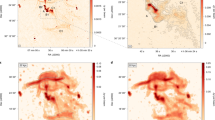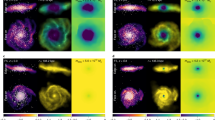Abstract
RADIATION pressure is believed to be the dominant force on gas in or near quasi-stellar objects (QSOs) under some conditions1,2, and I have studied the acceleration of a particle to relativistic velocities by radiation pressure in an inverse-square (1/r2) radiation field with the gravitational force neglected2. But although arguments have been given3,4 that the line emission regions of QSOs are not close to Schwarzschild singularities, it is nevertheless possible that a small portion of the redshifts of QSOs may be gravitational, and it is also likely that highly ionized or stripped material lies close to the central source, where the effects of general relativity are larger. In Newtonian theory, both the radiation pressure and the gravitational force vary as r−2, so that a particle of constant cross-section σ released at rest is either swallowed up or driven out, independent of its initial location. Here, I show that according to general relativity the result is different. For stationary particles the force of radiation pressure varies more rapidly than that of gravity with changing distance r to the central source. This makes stable equilibria possible. Collective effects, the effects of time variations in the strength of the radiation field and the changing opacity of the gas may well dominate the general relativistic effect discussed here. Thus, I am not proposing that the emission or absorption clouds of QSOs are necessarily stabilized in this way, but rather pointing out the, presence of this stabilizing effect, in contrast with a previous suggestion in the literature5. Although Fowler and Hoyle5 do not explicitly state that stabilization could not occur in the relativistic case, they imply this by favourably comparing the stabilization in their model with that of a point source in the Newtonian approximation.
This is a preview of subscription content, access via your institution
Access options
Subscribe to this journal
Receive 51 print issues and online access
$199.00 per year
only $3.90 per issue
Buy this article
- Purchase on Springer Link
- Instant access to full article PDF
Prices may be subject to local taxes which are calculated during checkout
Similar content being viewed by others
References
Scargle, J. D., Caroff, L. J., and Noerdlinger, P. D., Astrophys. J. Lett., 161, L115 (1970)
Noerdlinger, P. D., Astrophys. Space Sci., 13, 70 (1971).
Greenstein, J. L., and Schmidt, M., Astrophys. J., 140, 1 (1964).
Schmidt, M., Ann. Revs. Astron. Astrophys., 7, 527 (1969).
Fowler, W. A., and Hoyle, F., Nature, 213, 373 (1967).
Vaidya, P. C., Nature, 171, 260 (1953).
Kaufmann, W. J., Astrophys. J., 153, 849 (1968).
Lindquist, R. W., Schwartz, R. A., and Misner, C. W., Phys. Rev., 137, B1364 (1965).
Robertson, H. P., and Noonan, T. W., Relativity and Cosmology, Sections 4.4, 4.9 and 10.5 (Saunders, Philadelphia, 1968).
Hubble, E. P., The Realm of the Nebulae, 182 (Yale University Press, 1936).
Sandage, A. R., J. Soc. ind. appl. Math., 10, 780 (1962).
Author information
Authors and Affiliations
Rights and permissions
About this article
Cite this article
NOERDLINGER, P. Radiation Pressure on a Test Particle in General Relativity. Nature 237, 30–31 (1972). https://doi.org/10.1038/237030a0
Received:
Issue Date:
DOI: https://doi.org/10.1038/237030a0
This article is cited by
-
An improved radiation metric
General Relativity and Gravitation (1976)
-
Radiation Pressure on Dust in General Relativity
Nature Physical Science (1972)
Comments
By submitting a comment you agree to abide by our Terms and Community Guidelines. If you find something abusive or that does not comply with our terms or guidelines please flag it as inappropriate.



